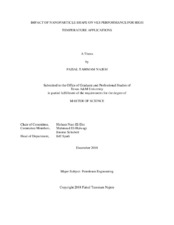| dc.contributor.advisor | Nasr-El-Din, Hisham A | |
| dc.creator | Najem, Faisal Tammam | |
| dc.date.accessioned | 2019-01-23T21:30:21Z | |
| dc.date.available | 2020-12-01T07:32:17Z | |
| dc.date.created | 2018-12 | |
| dc.date.issued | 2018-12-03 | |
| dc.date.submitted | December 2018 | |
| dc.identifier.uri | https://hdl.handle.net/1969.1/174574 | |
| dc.description.abstract | Viscoelastic surfactants were introduced in hydraulic fracturing fluids as a proppant carrier in order to replace polymers which possess high potential for formation damage. Yet, VES technology is limited by its low thermal stability and high leak-off behavior in high permeability formations. This work aims to design a VES based hydraulic fracturing fluid assisted by various nanoparticles to enhance its rheological properties and extend its thermal stability to 285oF and 350oF.
This study examined iron oxide nanoparticles and nanorods and silica nanoparticles and nanorods with cationic and anionic VES solutions. A brine of 23 wt% CaCl2 was used as a base fluid with different concentrations of both VES and nanoparticles. The dispersion of nanoparticles and rods was conducted by ultra-sonication for 10 minutes before the addition of VES. The rheology of each fracture fluid was assessed at 280 and 350oF at a shear rate of 100 s-1. Furthermore, both of the storage and loss moduli were examined to assess the fluid network structure and its carrying capacity for proppant delivery. The colloidal and macro properties of the nanoparticles and the VES mixtures were examined using a polarizing microscope before and after exposure to the high temperatures.
The addition of 7 pptg nanoparticles to the different VES solutions showed an extension and enhancement in the system rheological properties at high temperatures. The iron oxide nanoparticles extended the thermal stability of the fracturing fluid maintaining its viscosity above 75 cP for two hours compared to 30 minutes before its addition.
Although the microscopy examination showed homogenous distribution of the nanoparticles in the VES system before being heated, it showed agglomeration after the test which explained the failure after 2 hours. On the other hand, the silica nanoparticles succeeded to hold the viscosity above 75 cP for a longer time not showing degradation or loss in performance. This time the optical microscopy showed similar images before and after the test showing higher stability at 280oF and absence of agglomerates.
This work examined the impact of two nanoparticles and nanorods on the rheological and thermal stability of cationic and anionic VES solutions. The optical microscopy study showed an ability to predict rheological properties of the fluid from its colloidal nature. The results from this work lay out a better design path for VES based fluids in fracturing and matrix acidizing technologies. | en |
| dc.format.mimetype | application/pdf | |
| dc.language.iso | en | |
| dc.subject | VES | en |
| dc.subject | Nanoparticles | en |
| dc.subject | nanorods | en |
| dc.title | Impact of Nanoparticle Shape on VES Performance for High Temperature Applications | en |
| dc.type | Thesis | en |
| thesis.degree.department | Petroleum Engineering | en |
| thesis.degree.discipline | Petroleum Engineering | en |
| thesis.degree.grantor | Texas A & M University | en |
| thesis.degree.name | Master of Science | en |
| thesis.degree.level | Masters | en |
| dc.contributor.committeeMember | El-Halwagi, Mahmoud | |
| dc.contributor.committeeMember | Schubert, Jerome | |
| dc.type.material | text | en |
| dc.date.updated | 2019-01-23T21:30:22Z | |
| local.embargo.terms | 2020-12-01 | |
| local.etdauthor.orcid | 0000-0001-7669-9020 | |


